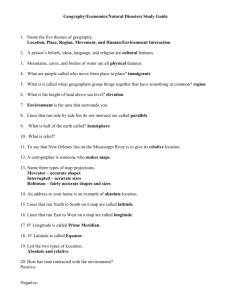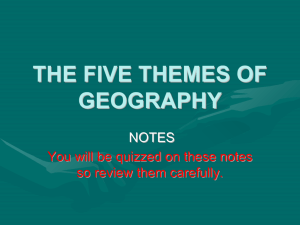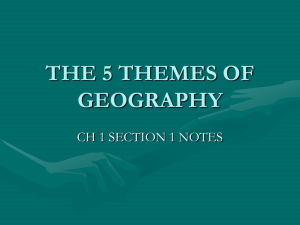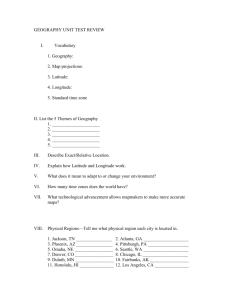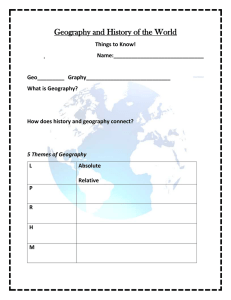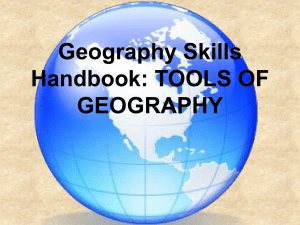Notes and assignments (updated 9-08)
advertisement
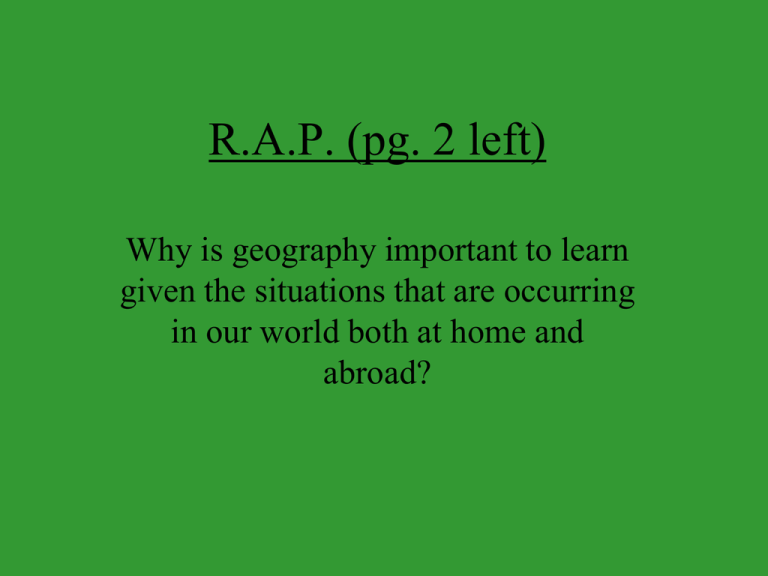
R.A.P. (pg. 2 left) Why is geography important to learn given the situations that are occurring in our world both at home and abroad? Geography Definitions (pg. 3 R) Geo: Earth Ography: The study of Geography: The study of the earth and the way people live and react to it. 5 Themes of Geography (pg. 5 R) 1) Location: Answers the question, “Where is it?” 2 Types: Absolute and Relative Location a) Absolute location: Exact location of a place using latitude and longitude. ex. Mary lives at 32 degrees N latitude and 15 degrees W longitude b) Relative location: Refers to a place in relationship to other places. ex. Mark lives on Windmere Lane across from the Wawa. 2) Place: Answers the question, “What is the place like?” using its human and physical characteristics. ex: Chalfont is a medium sized town with its own police force, schools and a major roadway (202) that connects it to other areas. 3) HEI (Human Environment Interaction): How people use, adapt to, or change their environment. ex: In the summer you wear shorts and in the winter you wear a coat due to the change in climate. 4) Movement: How people, goods, ideas and places are linked together. ex: Grunge music began in Seattle, Washington and soon spread across the U.S. and the world. Seattle U.S. and World 5) Regions: A way of organizing the world by its physical or human characteristics. ex: Tornado Alley, Latin America, time zones, Appalachian Trail 5 Themes Photo Hunt (pg. 4L) 1-Libya Location Place In Africa, East of Unami Junior High School A dry desert area with a few palm trees, but not much other plant life. Also looks like there are mostly older men HEI People use special head coverings to protect themselves from the heat and sand Movement Region Camels are used to transport people and other goods throughout the area In the Sahara desert region *Use class notes and information in your book to assist you complete the sheet Maps- pages R1-R26 Five Themes of Geography- pages Tools 6 – Tools 7 Latitude and Longitude (Pg.7 R) 1) Latitude: Imaginary lines that run east to (parallels) west but are measured north and south of the equator 30° N Any lines above the equator 15 ° N are north and 0 anything below 15° S are south! 30° S Equator 2) Longitude: Imaginary lines that run north (meridians) and south but are measured east and west of the prime meridian. Any lines right of the P.M.are East and anything left are West! 15 ° W 0°15 ° E 30° E 30° W Prime Meridian 3) Cardinal Directions: North East West South 4) Intermediate Directions: North West South West North East South East Putting Latitude and Longitude together (pg.6 L) Climate Zones (pg. 12 L) Polar Temperate Tropic Climate Cold 4 Seasons Suns Rays ½ indirect ½ direct ½ no rays ½ indirect Hot Direct rays all year Putting it all together (pg. 14 L) Vocabulary (pg. 17 R) 1)Hemisphere 4) Environment 2) Vegetation 5) Precipitation 3) Climate 6) Elevation

